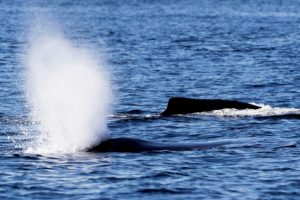Escuintla, Guatemala, Mar 4 (EFE).- A pair of humpback whales were swimming on the open sea with their calves, which weighed some 1 1/2 tons at birth. As the oceanic family passed close to Guatemala’s Pacific coast, the largest rolled over and with an enormous fin offered a friendly salute to the boats approaching it.
“Look, there they go – at any moment they’ll breach to breathe,” shouted Pedro Alvarado, a crew member of the yacht Sirena, normally used for sport fishing but which in the whale-watching season is at the service of tourists.
Pedro, 35, gazed over the vast sea looking for a trace in the water of the huge cetaceans, and every time the giant shapes were seen moving in the water or were heard to bellow, he shouted excitedly, “There go the whales, look!”
The whales swam close to the boat. They played together and swam in a synchronized choreography. They dropped their tails down deep and with a flick of their tail fins drove themselves some 30 meters (100 feet) ahead. The sea was calm, making it easier to see this oceanic spectacle.
The young sailor, talkative and very pleasant, said that from November to March, fishermen regularly spot humpback whales.

“They leap out of the water close to us when we’re fishing in the morning,” he said. “They’re so enormous they could capsize the boats but never do.
They’re friendly. They’re not aggressive. And everyone is surprised that an animal that big doesn’t attack them.”
The whales normally inhabit waters close to Alaska, but seek warmer waters to reproduce. That is when they head for Guatemala, where they mate and give birth to their calves (with Guatemalan passports) after a 12-month gestation period.
According to the experts, the largest humpback whales are the females, which can weigh as much as 20 tons. They can be impregnated every two to three years
In recent years, recreational whale-watching has increased, so the National Council of Protected Areas and the Guatemalan Tourism Institute have established regulations for sighting the cetaceans and protecting them throughout this season.
Owners of boats used for this activity must comply with all the rules and must be granted permits. Among the requirements is the speed of approaching the giant sea mammals – 9 kph (5 1/2 mph) – and the minimum distance from which they may be observed – 200 meters.
The Sirena yacht complies with those rules. It followed the whale family for at least half an hour. From time to time, the majestic, immense and elegant whales swam up so their backs were above water and then exhaled, shooting a high-pressure stream of water some 5 meters into the air. The yacht crew shouted with astonishment, as it does every time that happens.
After the 30-minute limit, the boat sailed away. Otherwise, the mammals could have felt harassed and the mother whales might have considered their calves in danger. As a result they could have reacted aggressively, though up to now no whale attacks have been reported in Guatemala.
On the 10-nautical-mile tour on the open sea – some five hours – there were sightings of olive ridley sea turtles which spawn on the beaches, and of bottlenose dolphins, which swim in pods from 50 to 100. They like getting close to boats, swimming around them and making whistling sounds like a kind of greeting.
Pedro said that sailors and local fishermen believe that when one of their number dies who spent most of his life at sea, he is reincarnated as a dolphin.
“For that reason dolphins approach our boats to greet us – they could have been sailors in a previous life who feel a certain nostalgia for boats.”
